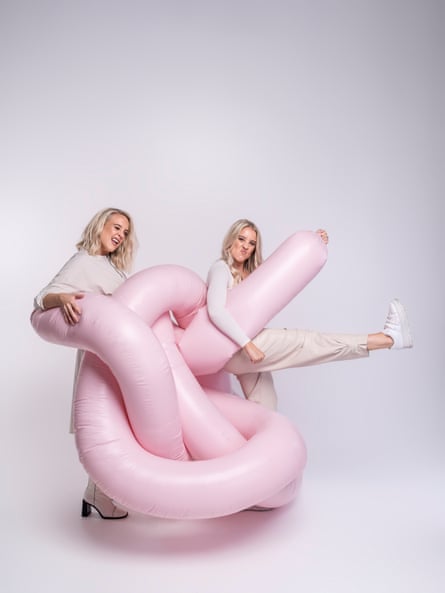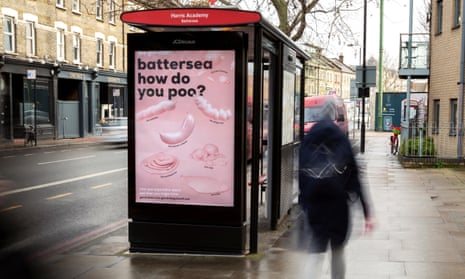I was minding my own business on a lockdown walk when I saw the advert on the side of a bus shelter. It featured seven shiny pink shapes. Were those sex toys, I wondered, interspersed with puddles of Angel Delight? Only when I read the captions (“The smooth criminal, the smashed avo, the poonami; London, how do you poo?”) did I realise what I was looking at.
These, it turned out, were visual metaphors for assorted types of stool. And of course, in the Instagram era, they were millennial pink. Literally polished turds, they were part of a campaign by The Gut Stuff, a startup that has the strapline: “Empowering gut health in everyone”.
My interest was piqued. So I went online and found that poo just kept popping up. A fascination with faeces – or stool-gazing as it is sometimes known – is burgeoning on the internet.
Another company, Seed, which sells high-end probiotics in sleek frosted glass containers, often posts illustrations of number twos on Instagram. Like The Gut Stuff, it frequently refers to the Bristol stool chart, a clinical assessment tool designed in 1997 to classify human waste, which it describes as “a decoder for your toilet bowl – and for your digestive health”.
In 2020, Seed created a citizen poo-pic database with which to train artificial intelligence to categorise excrement. The CEO and co-founder Ara Katz hopes that “more reliable and consistent data collection” via AI could “power important and actionable insights for gastrointestinal health and the correlation between specific inputs (diet, alcohol etc) and outputs (stool type, regularity etc)”. Another new app, Moxie Poop Scanner, claims it can categorise stools already, with the aim of helping you “learn more about whether your digestive health is on track”. Its website warns it “still has its training wheels on”, however, and in a Wired review last July it could not always differentiate between the writer’s face and her faeces.
Poo is frequently addressed in wellness and spiritually quizzes, many of which are inspired by the Indian alternative therapy ayurveda, which has used faecal matter as a health indicator for thousands of years, as has Chinese medicine. Gwyneth Paltrow is, inevitably, involved. A recent blogpost on her Goop website – headlined “all your poop questions, answered” – offered advice on posture and technique alongside “Goop your Poop” products. These included $60 Debloat+ supplements, a $220 blond wood “essential bathroom” foot rest – so you can mimic squatting on your loo, for more ergonomic excretion – and a $649 “luxury” seat that converts your toilet into a bidet and blow-dries your bottom.

Much of this content is inspired by recent research into the gut microbiome, linking it with an array of diseases and conditions from anxiety to diabetes to autism, and the explosion of gut-friendly products – from kombucha to probiotics – launched by the $4tn wellness industry.
Stool-gazing has history in the west, as well as India and China. It was only at the end of the middle ages that our current squeamishness started to develop, according to Prof David Inglis, author of the winningly named A Sociological History of Excretory Experience: Defacatory Manners and Toiletry Technology. Previously, he says, “human waste was all over the place – we were much more relaxed about it”.
While some level of poo aversion has always existed, and may even have an evolutionary purpose, to avoid the spread of germs, it took hundreds of years to develop our current level of repulsion. “Gradually, people got more uptight about smelling and seeing it, and started to find it more repulsive. It started in aristocratic circles – in the 19th century, the upper classes really were disgusted – then it trickled down.” This aversion fuelled city planning and housing design, Inglis says. Though there are modern exceptions, such as the “viewing platforms” that briefly display your output in German toilets, these days most European and US lavatories are an exercise in denial. “Just flush and it’s gone. You don’t have to face the fact that your body produces nasty stuff.”
But while busting taboos is generally considered a good thing in 2021, a burgeoning interest in excrement was not necessarily welcomed by the clinicians I spoke to. To be clear, there are times when monitoring one’s waste can be lifesaving. “If you have a change in the nature of your stool for three weeks, particularly if it gets looser, that is a reason to go and see your doctor. It can be associated with cancer, though most of the time isn’t,” says Prof Laurence Lovat, director of the London Gastroenterology Centre and professor of gastroenterology at University College London.
The NHS advice is to visit your GP if there is blood in your stool for three weeks (which Lovat describes as the “magic time … Less than that and it might simply be a burst haemorrhoid or, if you have diarrhoea, you may still be getting over gastroenteritis”). Changes to the shape of your stool, he says, are “usually completely meaningless”. And, while producing a poo that sits in the middle of the Bristol stool chart is often said to be a good sign of overall health, says Lovat, “that may not be true for everyone. Generalising is not a good idea because it ingrains health-related anxiety, which brings its own problems.”
“The Bristol stool chart wasn’t designed for this,” agrees Dr Duane Mellor, a British Dietetic Association spokesman and registered dietitian, referring to what he terms “lifestyle stool-gazing”. Clinically, the Bristol scale is used to evaluate the effectiveness of treatments, or to help doctors diagnose irritable bowel syndrome (IBS), among other things. But Mellor has concerns about consumers using it, and focusing on poo too much, which may cause other symptoms and conditions to be overlooked.
The ins and outs of gut health are dizzyingly complex. There have been some astonishing recent scientific advances, says Lovat, “but we are at a very early stage of understanding it. The problem is that people then jump on top of that and issue pseudoscience, which is very confusing for the public.” In other words, there is a lot of poo woo on the internet, and with four in 10 people reporting digestive symptoms and two in 10 reporting that they have IBS, there is a huge audience seeking answers.
Alana and Lisa Macfarlane, the co-founders of The Gut Stuff, point out that poo woo is not what they are selling. The pink stools in their advert were not designed to be diagnostic, they say, but to raise awareness about gut health in general.

The pair – who are identical twins and former BBC 1Xtra and Love Island: Aftersun DJs – got an inside track on gut microbiome research during many years volunteering in twin research. Coming from a working-class Scottish family, says Lisa, “we didn’t know what wellbeing was – we certainly didn’t know what gut health was”. When they found out, they were keen that this knowledge should “never be a middle-class luxury”. So they launched a company and website – thegutstuff.com – on the side of their broadcasting careers, collating some of their findings.
After finding themselves “in SEO heaven” (Google searches for gut health rose by 400% between 2015 and 2020), they built a considerable community, including more than 96,000 Instagram followers. They now sell high-fibre snack bars, fermenting kits and handbag-sized gut diaries, with space to make notes on food, stress, sleep, exercise, symptoms and, of course, poo. They are not offering a “Queer Eye makeover”, says Lisa. “It’s more about tuning in” and giving customers the tools and language to report symptoms to their doctors, says Alana.
They unpick the latest research in digestible chunks in their book, The Gut Stuff: An Empowering Guide to Your Gut and Its Microbes (Tim Spector, who heads the department of twin research at King’s College London, wrote the foreword), and acknowledge that gut research is incomplete and sometimes contradictory. Their practical advice is not radical – lots of fruit and veg, avoid processed foods, drink water, do exercise and maybe try a bit of fermented cabbage. They readily admit that, while poo is a great marketing tool, it might not be much of a divining rod. “It’s difficult,” says Alana, because “your normal might not be someone else’s normal.”
With all that in mind, without a very specific medical reason to do so, stool-gazing starts to feel a bit like reading tea leaves. That it would catch the imagination in lockdown makes sense, when so many of us are confined at home, cooking more, never more aware of health, seeking self-improvement where we can find it. I, for one, suspect I would have barely noticed The Gut Stuff’s advert in the beforetime, when I was running around between appointments.
That the experts say stool-gazing isn’t a habit I need to take up is a relief – and not just because, with a toddler at home, it would be something of a busman’s holiday. Instead, current gut health advice remains similar to the kind my gran used to give me. Mellor advises thinking about “those sad, boring things, like plenty of vegetables, fluid, fibre and exercise”. And also asking: “Have you got a regular habit? Is it comfortable to pass the stool?” and deploying good pot position. “People used to lean forward, holding a newspaper. Now they sit back with a phone or device,” he says, which causes problems. But a $200 Goop footstool is not necessary. “Just sit forward,” he says.
